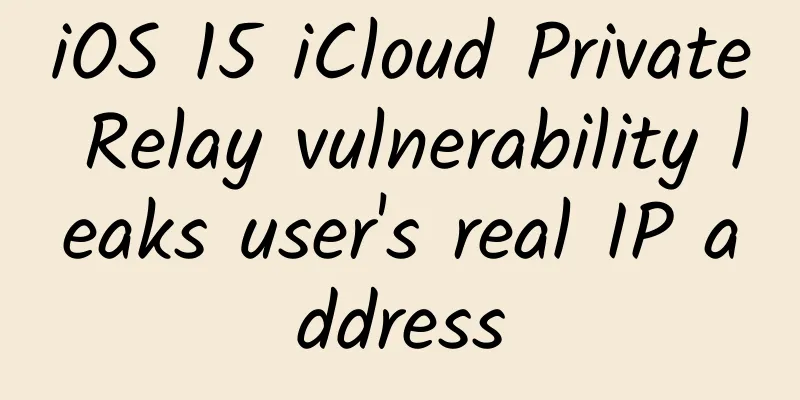iOS 15 iCloud Private Relay vulnerability leaks user's real IP address

|
The iCloud private relay service vulnerability introduced in Apple iOS 15 caused the user's real IP address to be leaked. iCloud Private Relay service is a new feature introduced in Apple's iOS 15 beta, which allows users to browse the Internet in a more secure and private way through the Safari browser. The service ensures that the traffic leaving the device is encrypted, and uses 2 Internet relays to allow users to browse the Internet without using their real IP address and location. Client IP address leaks using iCloud Private RelayFingerprintJS security researchers found that users can obtain the proxy's IP address through HTTP requests received by the server. The real IP address of the client can also be obtained through webRTC. WebRTC (web real-time communication) is an open source project that aims to provide real-time communication for web browsers and mobile applications through APIs, which can achieve point-to-point audio and video communication without installing plug-ins or apps. The real-time media information exchange between two terminals is established through a discovery and negotiation process called signaling. A framework called interactive connectivity establishment (ICE) is used in signaling. There are two methods in the framework that can be used to find and establish connections. FingerprintJS researchers found that when data needs to be transmitted between terminals through the NAT (Network Address Translation) protocol, the STUN server will generate a "Server Reflexive Candidate". STUN is a tool used to extract the public IP address and port number of the network device behind NAT. The vulnerability stems from the fact that STUN requests are not proxied through iCloud Private Relay, which will cause the client's real IP address to be exposed when ICE candidates are exchanged during the signaling process. FingerprintJS said it has reported the security vulnerability to Apple, and Apple has fixed it in the latest version of macOS Monterey. However, it is still not fixed in iOS 15 system using iCloud Private Relay. This issue shows that iCloud Private Relay cannot replace a virtual network. Users who want to hide their real IP address should still consider using a virtual network or browsing the Internet through Tor, and use JS to turn off WebRTC-related features when using the Safari browser. For full technical details, see: https://fingerprintjs.com/blog/ios15-icloud-private-relay-vulnerability/ This article is translated from: https://thehackernews.com/2021/09/apples-new-icloud-private-relay-service.html. If reprinted, please indicate the original address. |
<<: iFixit shares iPhone 13 Pro disassembly report: repairability is only 5/10 points
Recommend
How to configure the rental of a forum server with 100,000 IP addresses per day?
A forum website with 100,000 traffic per day can ...
From NetEase H5 and Durex, how can we mass-produce creative ideas that integrate brand and effect?
Starting from the cases of big names, we can cond...
How to invest in selling products through Juleliang Qianchuan Video? Detailed process explanation
Recently, many friends have been discussing Julia...
Blue Ocean Virtual Resource CPS Project, currently the highest single person earns over 300,000 yuan per month
The course comes from Shengfan’s Blue Ocean Virtu...
Breaking down the rules for taking notes on popular articles on Xiaohongshu!
This article analyzes the hottest articles on Xia...
How to write heartfelt copywriting in 3 steps?
Nowadays, if you don’t have any copywriting skill...
Can home appliances labeled “Level 1 low energy consumption” really save electricity and money?
I don't know when it started, but a colorful ...
Why didn’t the Samsung Note 7 explode during the recall?
The recall of Samsung Galaxy Note7 has entered it...
The secret to explosive growth in short video ads!
The "White Paper on the Value of Bytedance S...
In order to make iPhone X better for web browsing, I added a navigation button to the web page
Editor's note: After the release of iPhoneX, ...
Ele.me - The product operation logic behind being willing to wait for 5 minutes
Based on the market’s reactions and changes, Ele....
As the regional agent of Xindong Takeaway, what opportunities will Xindong Takeaway provide to ordinary people?
As Meituan Takeout has become the dominant player...
What kind of grass is this two-meter-high grass on the grave?
The popularity of customs such as planting willow...
If you don’t understand these 3 communication principles and 9 creative techniques, your content won’t be popular
The essence of marketing is communication. If the...









